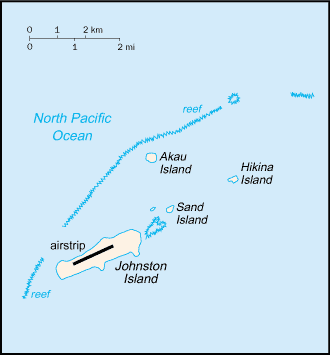Johnston Atoll is an uninhabited atoll in Polynesia, 717 nautical miles (1328 km) southwest of Hawaii, about one-third of the way to the Marshall Islands.
Understand

The atoll is closed to the public and travel to the island is not allowed without permission.
History
Both the US and the Kingdom of Hawaii annexed Johnston Atoll in 1858, but it was the US that mined the guano deposits until the late 1880s. Johnston and Sand Islands were designated wildlife refuges in 1926. The US Navy took over the atoll in 1934, and subsequently the US Air Force assumed control in 1948. The site was used for high-altitude nuclear tests in the 1950s and 1960s, and until late in 2000 the atoll was maintained as a storage and disposal site for chemical weapons. Munitions destruction is now complete. Cleanup and closure of the facility was completed by May 2005. Toxic waste from both operations is buried on the island.
The Fish and Wildlife Service and the US Air Force are discussing future management options, in the interim Johnston Atoll and the 3-mile Naval Defensive Sea around it remain under the jurisdiction and administrative control of the US Air Force.
Landscape
Strategic location in the North Pacific Ocean; Johnston Island and Sand Island are natural islands, which have been expanded by coral dredging; North Island (Akau) and East Island (Hikina) are manmade islands formed from coral dredging; egg-shaped reef is 34 km in circumference some low-growing vegetation. Highest point: Summit Peak, at 5 meters
Flora and fauna
Climate
Tropical, but generally dry; consistent northeast trade winds with little seasonal temperature variation.
Get in
You may be able to visit the island as a volunteer with the U.S. Fish and Wildlife service; see their website for details.
By plane
There is an abandoned airstrip on Johnston Island.
By boat
Fees and permits
See

Do
Buy
There is no economic activity on Johnston Atoll.
Sleep
There are no public accommodations on Johnston Atoll.
Stay safe
Go next

